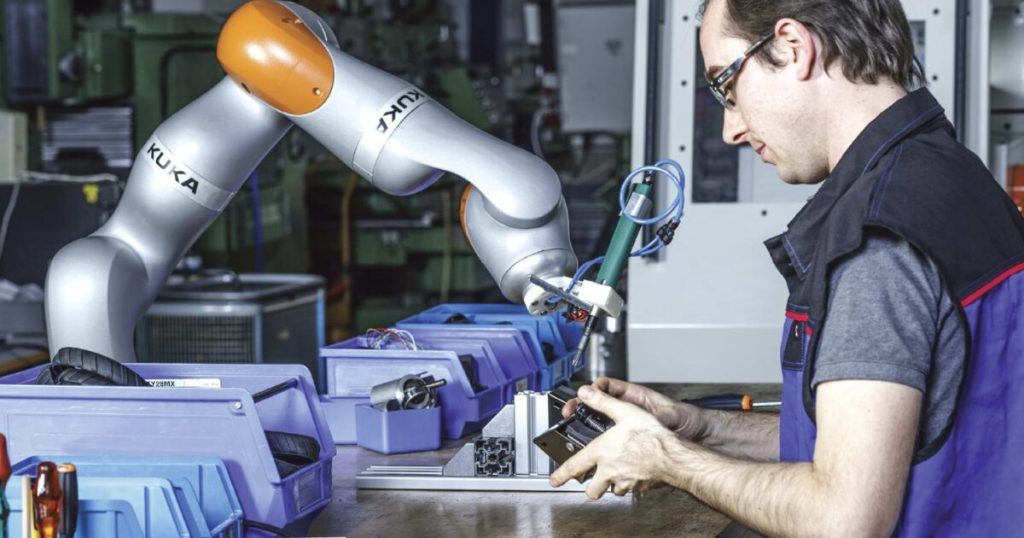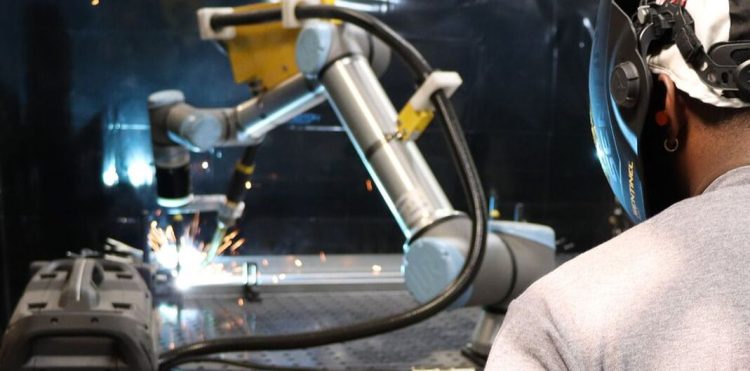Introduction
The rise of collaborative robots (cobots) marks a pivotal advancement in robotics technology, enabling robots and humans to work together in shared workspaces. Unlike traditional industrial robots, which are confined to isolated areas behind safety barriers, cobots are designed to interact safely with human workers in dynamic, real-time environments. While this collaborative approach offers significant advantages—such as improved productivity, flexibility, and efficiency—it also introduces a series of critical safety challenges that must be addressed to ensure the well-being of human operators.
As cobots work in close proximity to humans, they must be equipped with sophisticated safety mechanisms to avoid accidents. These mechanisms range from advanced sensing systems that detect human presence to force-limiting technologies that ensure safe interactions. The challenge lies in creating systems that are both efficient and safe, capable of responding to the unpredictability of human behavior while maintaining high performance levels.
This article explores the various challenges and solutions related to ensuring safe human-robot interaction (HRI) in collaborative robotics. We will discuss the key safety risks, the standards and regulations guiding cobot development, and the technologies designed to mitigate these risks. Furthermore, we will explore the future of human-robot collaboration and the evolving safety protocols that will shape this growing field.
1. The Emergence and Importance of Collaborative Robots
Collaborative robots, or cobots, are robotic systems designed to physically interact with humans in a shared workspace, typically without the need for physical barriers. Unlike traditional robots that operate in isolated areas or are enclosed in cages, cobots are engineered to safely work in close proximity to human workers, either assisting with tasks or performing duties autonomously while humans are in the same environment.
Advantages of Collaborative Robots
- Improved Productivity and Efficiency: Cobots can perform repetitive or strenuous tasks, allowing human workers to focus on more complex, creative, or decision-based aspects of work.
- Flexibility in Operations: Cobots are often reconfigurable and adaptable to various tasks, making them highly versatile across different industrial applications, from manufacturing to healthcare.
- Enhanced Worker Safety: By taking over dangerous tasks, such as lifting heavy objects or performing hazardous processes, cobots reduce the risk of human injury.
Despite these advantages, the proximity of cobots to humans introduces a new set of challenges. Traditional safety protocols, which typically involve isolating robots from human workers, are insufficient in collaborative environments. New safety measures are required to address these concerns.
2. Key Safety Risks in Human-Robot Collaboration
Human-robot collaboration comes with a range of safety risks. These risks can be broadly categorized into three areas: physical risks, operational risks, and behavioral risks.
Physical Risks
Physical injuries are one of the most significant concerns in human-robot collaboration. When working in close proximity to humans, robots can pose risks such as:
- Crush Injuries: These injuries occur when a human is caught between a robot’s moving parts or between the robot and another object.
- Pinching or Impact Injuries: Robots that operate with force or precision could inadvertently cause harm if they make sudden or unanticipated movements.
- Cutting or Shearing Hazards: Some industrial robots, such as those used in manufacturing or assembly lines, may use sharp tools or blades that could cause cuts if they come into contact with a human worker.
Cobots are generally designed with force-limiting technologies that reduce these risks. For instance, robots may automatically slow down when they detect a human in their immediate vicinity, or they may be equipped with soft materials to minimize the severity of an accidental impact.
Operational Risks
Cobots must operate within the context of dynamic human behavior and changing environments. Some operational risks include:
- Unanticipated Human Movement: Humans may make unexpected movements that could place them in the robot’s path or interfere with its task.
- Sensor Failures: Cobots rely on a variety of sensors, including cameras, proximity sensors, and force sensors, to detect human presence and navigate their environment. Malfunctioning sensors or poor sensor coverage could lead to unsafe situations.
- Unreliable Communications: Cobots must interpret and respond to human actions in real-time, often requiring precise communication between the robot and human worker. If this communication is delayed or misinterpreted, it could result in accidents.
The implementation of real-time feedback systems and adaptive robot behaviors is essential to mitigating these operational risks. These systems enable robots to continuously monitor and adjust their actions based on the current environment and human activity.
Behavioral Risks
Human-robot collaboration also involves behavioral complexity. Some of the risks associated with human actions include:
- Distracted or Unaware Human Workers: If a worker is distracted or unaware of the robot’s movements, they may enter the robot’s workspace unexpectedly, leading to potential collisions.
- Inconsistent Task Execution: Cobots are designed to assist with specific tasks, but human workers may change how they interact with the robot, which could lead to inconsistent or unsafe robot behavior.
Behavioral risks can be mitigated through advanced human-robot interaction design and intuitive interfaces that enable better communication and understanding between humans and robots.

3. Standards and Regulations for Collaborative Robot Safety
To ensure the safety of human-robot collaboration, international organizations have developed standards and regulations specifically for cobots. These safety standards aim to guide the design, deployment, and operation of cobots to minimize risks and ensure safe working conditions.
ISO 10218: Industrial Robots – Safety Requirements
The ISO 10218 standard outlines general safety guidelines for industrial robots, including collaborative robots. This standard provides specifications for robot design, operation, and safety features. Key components of ISO 10218 include:
- Risk Assessment: A thorough evaluation of potential risks is required before deploying a robot in a collaborative environment.
- Safety-rated Monitored Stop: This standard emphasizes the need for robots to stop automatically when a human enters their workspace. It ensures that robots do not continue moving or apply excessive force when a person is detected.
- Safety Barriers: In some cases, physical barriers may still be required to separate humans and robots, depending on the nature of the task and risk assessment.
ISO/TS 15066: Collaborative Robots Safety Guidelines
For cobots specifically, the ISO/TS 15066 standard provides a more detailed set of guidelines, addressing safety concerns unique to collaborative robotics. Some of the key guidelines include:
- Force and Pressure Limits: The robot must not exceed certain force or pressure thresholds when making contact with a human. For example, the robot should not apply enough force to cause injury if it accidentally bumps into a worker.
- Speed Control: Cobots should operate at lower speeds when interacting with humans, reducing the risk of injury during unexpected movements.
- Power and Force Limiting: Cobots are equipped with sensors that limit the power and force exerted during interactions. This is particularly important for tasks such as lifting, assembling, or manipulating materials.
Other Regional Safety Standards
In addition to ISO standards, other regional safety regulations also play a critical role in ensuring the safe integration of cobots into the workplace. For instance:
- European Union: The EU’s Machinery Directive outlines safety requirements for robots, ensuring compliance with general safety and health regulations.
- United States: OSHA (Occupational Safety and Health Administration) provides guidelines for the safe operation of robots, ensuring that employers follow safety protocols when deploying cobots.
4. Technologies Enhancing Safe Human-Robot Interaction
To enhance the safety of human-robot interactions, several innovative technologies have been integrated into cobots. These technologies enable robots to understand, react to, and adapt to the presence of human workers in real time.
Advanced Sensors and Perception Systems
- Proximity Sensors: These sensors detect the presence of humans and trigger safety responses, such as slowing down or stopping the robot’s motion. Proximity sensors are essential for preventing collisions.
- 3D Vision and LIDAR: By employing 3D cameras and LIDAR (Light Detection and Ranging) systems, robots can create detailed maps of their environment and detect obstacles or human workers with greater accuracy.
- Force Sensors: These sensors allow robots to sense the force they are applying, enabling them to react if they come into contact with a human. By adjusting their force based on real-time data, robots can prevent injuries.
Artificial Intelligence and Machine Learning
AI and machine learning technologies are being used to improve the safety and adaptability of robots. For example:
- Predictive Behavior: AI can help robots predict human movement patterns and adjust their actions accordingly, preventing unexpected collisions.
- Adaptive Behavior: Machine learning algorithms allow cobots to learn from their experiences and improve their interactions with human workers over time.
Compliance and Soft Robotics
Some cobots are designed with soft robotics principles, which allow their components to be flexible and compliant. This flexibility reduces the risk of injury if a robot accidentally bumps into a worker. Soft robotics also allows cobots to perform delicate tasks, such as handling fragile materials or assisting with medical procedures.
5. Future Directions in Safe Human-Robot Collaboration
As cobots become increasingly integrated into the workplace, the demand for advanced safety features will continue to grow. Several trends indicate that human-robot collaboration will evolve with an increased focus on safety, including:
- Improved AI for Smarter Safety: AI will continue to enhance robots’ ability to recognize, anticipate, and respond to human actions. Future cobots may even be able to predict the intentions of human workers and adapt their actions accordingly to ensure safe interactions.
- Wearable Safety Devices: To further improve safety, wearable devices for workers, such as exoskeletons or motion tracking systems, could work in tandem with cobots, enabling the robot to adjust its behavior based on real-time data from the worker.
- Autonomous Safety Protocols: As robots become more autonomous, their ability to identify and respond to safety hazards will become more sophisticated. For instance, cobots may use real-time data from environmental sensors and human monitors to automatically adjust their actions to prevent accidents.
Conclusion
Ensuring safe human-robot interaction is a fundamental challenge in the development of collaborative robot technology. While cobots offer tremendous benefits in terms of efficiency, flexibility, and safety, their close proximity to human workers introduces complex safety risks. Addressing these risks requires a multifaceted approach, including the development of advanced safety standards, the integration of cutting-edge technologies, and a deep understanding of human-robot collaboration dynamics.
As the field of collaborative robotics continues to evolve, safety will remain a top priority. With ongoing advancements in sensor technology, AI, and machine learning, the future of human-robot collaboration holds promise for even safer, more productive working environments where robots and humans work seamlessly together.







































